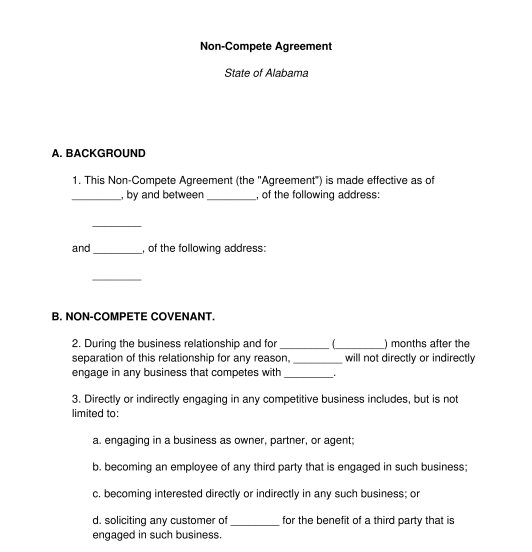 10/27/2025
10/27/2025

Answer a few questions and your document is created automatically.

Your document is ready! You will receive it in Word and PDF formats. You will be able to modify it.




Rating: 4.8 - 563 votes
Download a basic template (FREE) Create a customized documentA non-compete agreement is a document used to protect employers from employees, contractors, and other individuals with access to their business secrets and practices using that access to leave the company to start their own competing business in the same industry.
Non-compete agreements are most often used in highly competitive industries, such as technology development, sales, and marketing. Common situations that would require the use of a non-compete agreement include the following:
For more information about the scope of non-compete agreements, please refer to the guide Important Considerations before Asking an Employee to Sign a Non-Compete Agreement.
Though both documents are used in employment relationships, they constrain employees in different ways.
A non-compete agreement prevents an employee from leaving their employer to start a competing business in the same industry and same geographic location. It is not about the disclosure of information but instead about the initiation of competition.
A non-disclosure agreement stops an employee from sharing specific business secrets and practices outside the company.
No, it is not mandatory to have a non-compete agreement. Employers can decide to allow their former employees and business collaborators to set up competing businesses once they leave the company.
However, many employers choose to use non-compete agreements to lessen competition and ensure that employees do not use what they learned working for them to eventually take away business from them.
Solicitation is the practice of a former employee contacting the employer's clients and customers in an attempt to get their business. This can also entail former-employees trying to contact current employees and inducing them to leave the employer to work for them instead.
Generally, non-compete agreements with very broad geographical boundaries or restrictions beyond where the employer's business actually operates are not reasonable and, therefore, not legally enforceable.
For example, a business that operates strictly in one town would have trouble imposing a nationwide non-compete agreement. The legality of restrictions in the agreement will be determined on a case by case basis in court.
Courts are typically unwilling to enforce agreements judged to be excessively long. What is considered excessively long varies from state to state, but a 36 month, or 3 year, maximum is usually a good rule of thumb.
Once it has been written, this non-compete agreement must be hand signed and dated by both the non-competing party and the party who is being protected from competition. After they have both signed and dated the document, they should each keep a copy of the document for their records in case of future dispute. No further notarization or registration is necessary for this document to take effect and be binding on the parties.
A valid non-compete agreement must contain at least the following mandatory clauses:
In addition to the above mandatory clauses, the non-compete agreement may include the following additional information:
Non-compete agreements are the subject of state law and are interpreted and enforced differently from state to state. Some states allow broader non-compete agreements, while other states will only enforce agreements with significant durational and geographical limitations. Notably, California courts will only enforce non-compete agreements in situations involving the sale of a business from one party to another. State law should be consulted to be sure that the Agreement will be fully enforceable in that state. For more information about the enforceability of non-compete agreements in each state, please refer to the guide What is the Enforceability of Non-Competes in my State.
You fill out a form. The document is created before your eyes as you respond to the questions.
At the end, you receive it in Word and PDF formats. You can modify it and reuse it.
Guides to help you
Non-Compete Agreement - FREE - Template - Word and PDF
Country: United States